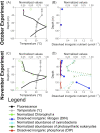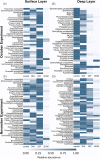Organic and inorganic nutrients modulate taxonomic diversity and trophic strategies of small eukaryotes in oligotrophic oceans
- PMID: 37333435
- PMCID: PMC10117809
- DOI: 10.1093/femsmc/xtac029
Organic and inorganic nutrients modulate taxonomic diversity and trophic strategies of small eukaryotes in oligotrophic oceans
Abstract
As the oligotrophic gyres expand due to global warming, exacerbating resource limitation impacts on primary producers, predicting changes to microbial assemblages and productivity requires knowledge of the community response to nutrient availability. This study examines how organic and inorganic nutrients influence the taxonomic and trophic composition (18S metabarcoding) of small eukaryotic plankton communities (< 200 µm) within the euphotic zone of the oligotrophic Sargasso Sea. The study was conducted by means of field sampling of natural microbial communities and laboratory incubation of these communities under different nutrient regimes. Dissimilarity in community composition increased along a depth gradient, with a homogeneous protist community within the mixed layer and distinct microbial assemblages at different depths below the deep chlorophyll maximum. A nutrient enrichment assay revealed the potential of natural microbial communities to rapidly shift in composition in response to nutrient addition. Results highlighted the importance of inorganic phosphorus availability, largely understudied compared to nitrogen, in constraining microbial diversity. Dissolved organic matter addition led to a loss of diversity, benefiting a limited number of phagotrophic and mixotrophic taxa. Nutrient history of the community sets the physiological responsiveness of the eukaryotic community to changing nutrient regimes and needs to be considered in future studies.
Keywords: biodiversity; dissolved inorganic phosphorus; marine protists; metabarcoding; nutrient competition; trophic strategy.
© The Author(s) 2022. Published by Oxford University Press on behalf of FEMS.
Conflict of interest statement
None declared
Figures











Similar articles
-
Establishment of microbial eukaryotic enrichment cultures from a chemically stratified antarctic lake and assessment of carbon fixation potential.J Vis Exp. 2012 Apr 20;(62):3992. doi: 10.3791/3992. J Vis Exp. 2012. PMID: 22546995 Free PMC article.
-
Prokaryotic and eukaryotic microbial community responses to N and P nutrient addition in oligotrophic Mediterranean coastal waters: Novel insights from DNA metabarcoding and network analysis.Mar Environ Res. 2019 Sep;150:104752. doi: 10.1016/j.marenvres.2019.104752. Epub 2019 Jul 10. Mar Environ Res. 2019. PMID: 31326679
-
The protist community of the oligotrophic waters of the Gulf of Mexico is distinctly shaped by depth-specific physicochemical conditions during the warm season.FEMS Microbiol Ecol. 2025 Jan 28;101(2):fiaf009. doi: 10.1093/femsec/fiaf009. FEMS Microbiol Ecol. 2025. PMID: 39875193 Free PMC article.
-
Strong Seasonality in Arctic Estuarine Microbial Food Webs.Front Microbiol. 2019 Nov 29;10:2628. doi: 10.3389/fmicb.2019.02628. eCollection 2019. Front Microbiol. 2019. PMID: 31849850 Free PMC article. Review.
-
Significance of predation by protists in aquatic microbial food webs.Antonie Van Leeuwenhoek. 2002 Aug;81(1-4):293-308. doi: 10.1023/a:1020591307260. Antonie Van Leeuwenhoek. 2002. PMID: 12448728 Review.
Cited by
-
Soil Microbial Co-Occurrence Networks Across Climate and Land Use Gradient in Southern Italy.Environ Microbiol Rep. 2025 Apr;17(2):e70093. doi: 10.1111/1758-2229.70093. Environ Microbiol Rep. 2025. PMID: 40210220 Free PMC article.
-
Microeukaryote metabolism across the western North Atlantic Ocean revealed through autonomous underwater profiling.Nat Commun. 2024 Aug 25;15(1):7325. doi: 10.1038/s41467-024-51583-4. Nat Commun. 2024. PMID: 39183190 Free PMC article.
References
-
- Agis M, Granda A, Dolan JR. A cautionary note: examples of possible microbial community dynamics in dilution grazing experiments. J Exp Mar Biol Ecol. 2007;341:176–83.
-
- Antia NJ, Harrison PJ, Oliveira L. The role of dissolved organic nitrogen in phytoplankton nutrition, cell biology and ecology. Phycologia. 1991;30:1–89.
-
- Arrigo KR. Marine microorganisms and global nutrient cycles. Nature. 2005;437:349–55. - PubMed
LinkOut - more resources
Full Text Sources
Research Materials
